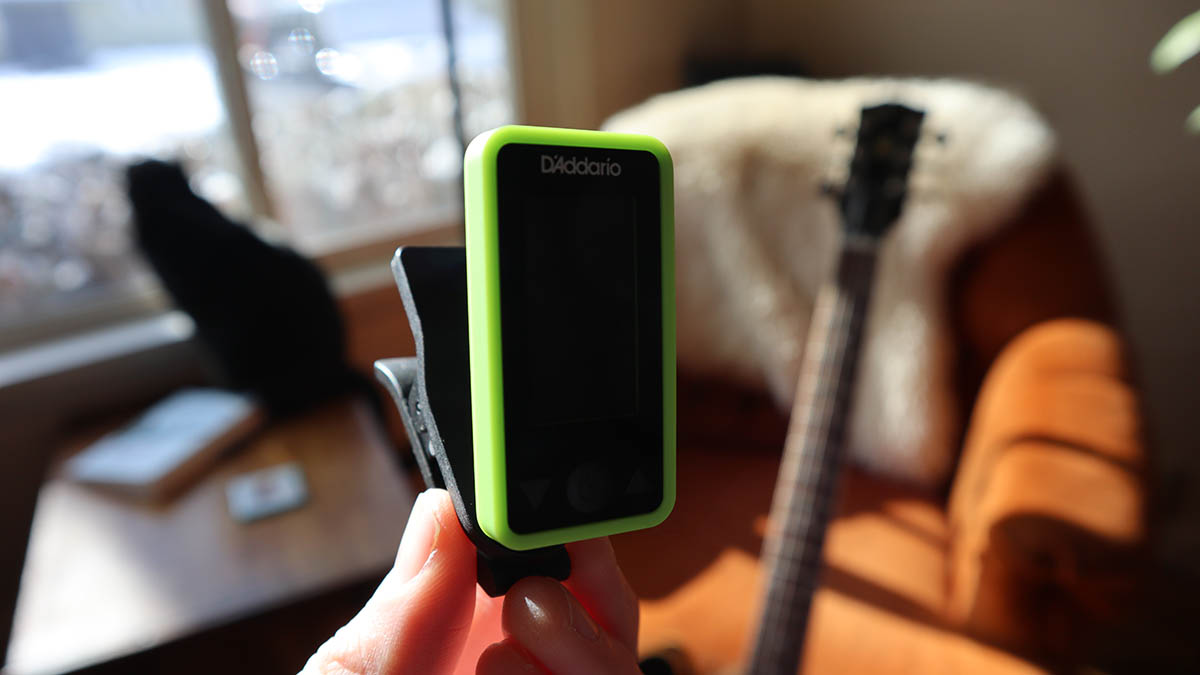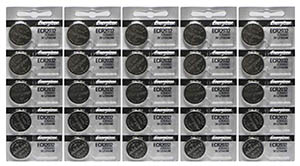While I’ve written about the best clip on tuners in the past, that article was more than two years ago and it’s time for an update. While not a ton has changed in clip on tuner tech since then, I’ve found a new favorite clip on tuner that I think everyone should have. Two years ago I pickup up the D’Addario Eclipse and haven’t bought another clip on tuner since. It is cheap, chromatic, has an incredibly long battery life, and has worked fantastically well on all of my guitars both acoustic and electric, and on my bass too.
There are other great tuners on the market so I’ll take an updated look at those, and then answer some common questions about clip on tuners.
Table of Contents
Our Top Pick
The D’Addario Eclipse Clip On Headstock Tuner
This is the perfect, no nonsense, clip on tuner that works great for guitars, bass, ukuleles, and other stringed instruments. Solid construction, bright display, and a cheap price tag make this the clip on tuner I’ll be using for a long time, and buying for my friends. I’ve been using this tuner for over 2 years straight on all of my acoustic, electric, and bass guitars and have yet to change the battery. It tunes quickly and accurately, and is chromatic. If I had a perfect tuner it would be this, I wouldn’t add or subtract a single thing from the D’Addario Eclipse.
Jump to full Review of D’Addario Eclipse
Snark SN-8 Super Tight All Instrument Tuner
While at one point in time the Snark was a mainstay at picking circles and on the headstocks of most bluegrass instruments, it has now become one of the bestsellers and most seen clip on tuner on any headstock. Snark has become a household name for guitar players, and for good reason. Their tuners have great displays, strong clamps, and a low price tag. The ball joint swivel and the bulkier design are slight grievances that bring this tuner into second place.
TC Electronic PolyTune Clip
While most clip on tuners basically perform the same function, the TC Electronic PolyTune Clip does something none of the others do. Strum all open strings and instantly see which are out of tune. That’s right, this tuner can hear all 6 strings as once and determine their individual tuning. It of course doubles as a normal chromatic tuner and will display single string values once you only pluck one string. The switching of modes is seamless and doesn’t require any change or button fumbling. The construction is the highest quality of all the clip on tuners and features all metal, with a fully metal clip, hinge, and spring. This is the best clip on tuner that I’ve ever used, the price tag being the only thing keeping this from the top of the list. If you can afford it, get this one!
What To Look For in a Clip On Tuner
Size / Bulkiness: A clip on tuner should attach neatly to the headstock of any guitar or bass and all you to easily see it whether sitting or standing. Partly you don’t want a tuner that is too bulky or else you run the risk of knocking it on objects around you. While you should be careful not to hit your guitar’s headstock on things, clip on tuners aren’t built to survive even the smallest of impacts. While the bulkiness of a tuner challenges its survivability factor, it also challenges the aesthetic of your guitar.
Let’s be honest, as musicians (and especially guitar players) we like to look cool. Or at least convince ourselves that we look cool. A bulky clip on tuner looks like you might as well tether a party balloon with your tuners. I appreciate a sleek design that can look discrete and nice while maintaining a screen large enough to easily see.
Screen Brightness: Most tuners don’t have any issue as long as you’re using it indoors. However, once in the sunlight many clip on tuners will have so much glare on the screen that it’s nearly impossible to see the lights. A bright screen makes all the difference if you ever use it in a light setting. Of course this will decrease battery life, so screen brightness is a tradeoff.
Clamp Strength: Clip on tuners work by sensing the vibrations coming through the instrument. In order for these vibrations to be transmitted effectively, the tuner needs a strong clamp with pads that maximize the surface area of contract on the instrument.
While I have never used a clip on tuner with a clamp with was too strong, this is something to be careful of as a vice grip on your instrument could do damage to the finish or the structure depending on where you’re clamping it. Most often you’ll find tuners that lack spring strength in their clamp. If the tuner is having trouble staying right where you left it then the spring is not strong enough.
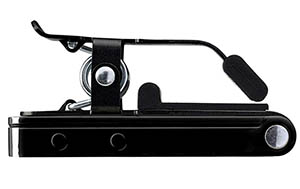
Swivel Type: When I’m looking at a tuner, the fewer swivel points the better. If you need to move the tuner head to see it, then just move the whole tuner. Making a tuner head that can move in three dimensions and do the splits is overkill and will inevitably fail at one of those joints. This is the biggest complaint of the Snark. The ball and socket joint allow for ultimate movement of the tuner head, but come at a disadvantage for longevity. I love the single pivot of the TC Electronic PolyTune. That thing will likely never break at that swivel point.
Chromatic: A chromatic tuner is an absolute must have for me. Most clip on tuners either have the option or an alternate model that provides a chromatic tuner. This can be tricky, but most tuners will say chromatic somewhere on them or in the description. I will say this with as much gusto as I can. DO NOT buy a guitar tuner that only tunes in the standard EADGBE. This is detrimental to beginning players, and will keep you from being able to tune your guitar in other tunings. I hate guitar only tuners so much, I wish we could melt them all in a huge bonfire. I have seen more people struggle with guitar tuners because they don’t give you any way to determine the note the guitar is actually tuned to if it isn’t one of the notes in the standard tuning. Whatever you do, do not buy a guitar only tuner. They are an absolute waste of money.
Features: There is a time and a place for features packed into a device. Clip on tuners are not one of those times. When evaluating a good clip on tuner, I want to see a solid chromatic tuner with a bright display and pretty much nothing else. The most extraneous features are different modes for different instruments. Just put it in chromatic mode and leave it be. I’ve never used those other modes and find them particularly frustrating. Tuners default to the standard A = 440, which is the most common tuning standard today. While I see the ability to change this as a plus, I’ve personally never done this. I only ever use the standard 440, and see this as a common pitfall for younger players. It’s easy to bump the buttons and change the tuning from the standard. You may not notice the change and be frustrated when your guitar doesn’t sound like the song you’re trying to learn. As a caution, make sure your tuner is set to 440 when using it.
Features I think have no place in a clip on tuner are, as mentioned, different instrument modes, metronomes, transposing, or any of that nonsense. I want a clip on tuner to do one thing and do that one thing well. Tune my guitar.
Battery: Most clip on tuners use a standard pancake style battery that is easy to replace and cheap to buy in bulk on Amazon. Jump to: What kind of battery does a clip on tuner use? Recently, I’ve seen some clip on tuners that use a rechargeable battery. I can’t think of many things more annoying than having your tuner run out of battery mid practice, or mid gig and having to find the adapter to plug it in so you can use it in six hours once it’s done charging.
Most clip on tuners these days are great at conserving energy and have auto-off features. In fact, I have been using my D’Addario Eclipse for two straight years and haven’t had to change the battery one time. I’m sure I will soon, but I’ll take that any day of the week over a rechargeable battery that will have to be thrown away once that battery hits the end of its life. No thanks.
Price: While I try to use most things until I absolutely have to get a new one, I view clip on tuners as partially expendable depending on how hard I use them, and knowing full well that I’ll lose them at some point. A tuner is much like a capo. You’ll either lose it and need to buy another, buy multiples for multiple guitars or rooms, or buy them for your friends and family because who can’t use another tuner? I know I’d love that as a gift. I’m looking to spend under $20 for a clip on tuner. There are rare exceptions, and those are for a truly unique and well made tuner like the TC Electronic PolyTune Clip. I’m also not willing to buy clip on tuners less than $10. I’ve used most of those and they truly are not very good once you go into that uber cheap range.
In-Depth Review: The D’Addario Eclipse

The D’Addario Eclipse has been my go to clip on tuner for the past 2 years straight. I’ve yet to change the battery, it has worked perfectly this whole time, and is my favorite clip on tuner that I’ve used so far. While other tuners may have cooler options (PolyTune Clip), this one has everything I need and nothing more.
It comes in a handful of colors, and while I got my in the lime green, I did that because it was the cheapest on Amazon. As of this writing, they are all the same price, but every once in awhile they’ll have deals on certain colors. Would I use this on stage? Eh, probably not. I’d get an all black one for that.
The clip has a nice strong grip to it which stays in place on the headstock of the guitar right where you leave it. The contact points on the tuner are a soft material that won’t damage the guitar’s finish and yet provide a strong connection to the instrument. While the body of the clamp is plastic, the hinge mechanism is wide enough to provide the axle with plenty of support. This is a common breaking point for cheaper tuners and something I notice right away since I’ve seen so many break there. The spring is strong and fully made of metal.
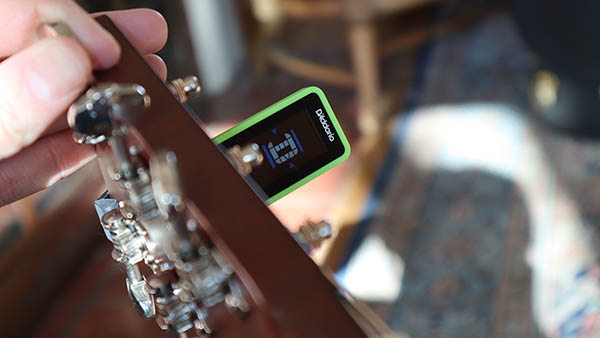
The body of the tuner is attached by a short arm and can tilt and twist. The arm attached to the clip can twist as well, providing a total of 3 points of movement. Typically this would be a drawback in my opinion (more points of failure will lead to more failure), but after two years of constant use, these joints are still strong, tight, and work like they originally did.
The display is bright and displays sharp and flat notes clearly and obviously. The D’Addario Eclipse does allow for the standard A = 440 to be changed up or down, but I haven’t ever used that feature and find I’m having to be careful to make sure I haven’t accidently hit one of those buttons to put my tuner in a different setting.
The D’Addario Eclipse is the perfect clip on tuner for my purpose. I use it constantly on my electric guitars, acoustic guitars, and even my bass. It does a wonderful job of tuning all of those instruments in whatever tuning I want to put them in. If this tuner bites the dust, I will be buying another of the exact same kind. This time, probably just in black.
The Good: The D’Addario Eclipse clip on tuner is sleek, with a well designed armature. It functions exactly how you’d want it to and features a nice strong display. The Eclipse is also the cheapest option on our list and will last for years. Great all around clip on tuner that hasn’t let me down in over 2 years of constant use.
The Bad: The only real downside of the D’Addario Eclipse is the screen which while being bright, may have more glare than the Snark in direct sunlight. The armature / pivot mechanism moves in 3 directions which provides more opportunity to break (though I haven’t seen any indication of wear in my 2 years of using it).
Conclusion: The D’Addario Eclipse clip on tuner is the best tuner that I’ve used for the money. It is relatively cheap, well made, and comes with just the right number of features. Battery life is great which is aided by not including extraneous features like a metronome. In my experience, the D’Addario Eclipse is the best clip on tuner for beginner guitar players. I will be buying more of these tuners for other rooms of my house, other instruments, and as gifts for my guitar playing friends.
In-Depth Review: The Snark SN-8
Just by the sheer popularity of the Snark clip on tuner, you may think that this is the best tuner on the market. And you really wouldn’t be that far off. The Snark, while not my favorite for a couple reasons that we’ll get into, is a great tuner offering a solid set of features and working quite well. Had it not been for a couple irksome features this tuner would most likely top my list.
Snark makes a handful of models of their clip on tuners, but the SN-8 is the standard for a chromatic tuner that will work on all instruments. It is designed with a super strong clamp and is the model I recommend for guitar players. It is the chromatic model as noted by the “all instruments” description in the title.
Snark tuners typically come in a variety of colors, but the SN-8 that I recommend only comes in black. This is sleek, flat black color that looks good and blends in well to the background. While the color of the Snark works for me, the bulkiness and size does not. While original designs, which had an awkwardly long arm that pivoted far too much and broke constantly, have been improved upon and swapped out for a much shorter armature, the big comical round dial of the tuner head just throws me off. This isn’t something that is going to bother everyone, but if I have to add something to my guitar I’m going to add something cool, not a giant bulb.
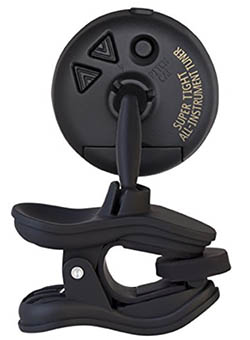
The two ball and socket joints of the arm is a weaker design that won’t stand up to as much abuse as other tuners like the D’Addario Eclipse or the TC Electronics Polytune. If you have kids, shy away from the Snark, which for some reason is a known kid magnet. Something about a natural law whereby if they can break something they will?
The loud bulbous face does supply a bright display over which is a matte finish which cuts down on glare considerably making the Snark a choice option if you’ll be using the tuner outside or in bright areas.
In terms of functionality, the Snark works great. It tunes quickly and accurately just as you’d expect, and works well on all instruments even beyond just guitar and bass. If you have an instrument like a trumpet, the Snark will even work great for that application.
The Snark SN-8 is a chromatic tuner which, like the other tuners on this list allow for the standard A = 440 to be changed (make sure it doesn’t). The Snark also includes a metronome function with tap tempo. Having a metronome on my phone, I can’t imagine using a clip on tuner for a metronome. I’m trying to extend the battery life as much as possible so I don’t have to buy small batteries. Running a metronome on the tuner is a good way to make that battery life much shorter.
The Good: The Snark SN-8 is a chromatic tuner designed to tune all of your instruments. It has a strong clamp with soft contact points that won’t ruin the finish of our instrument (if not left on for long periods of time). The tuner works great and features a strong, bright display that works well outside.
The Bad: The Snark SN-8 has a bulky design with an armature that is more prone to breaking. While the ball and socket joint is designed to pop out under stress, I’ve seen the socket break on numerous occasions.
Conclusion: The Snark is an awesome tuner that works great. If the size doesn’t bother you, and you’re not worried about little hands yanking the tuner head off the body, then the Snark SN-8 might be the perfect tuner for you.
In-Depth Review: TC Electronic PolyTune Clip
The TC Electronic PolyTune is a unique clip on tuner that expands on the standard function of any clip on tuner on the market currently. By strumming all of the open strings of your guitar at the same time, the PolyTune is able to pick up each one individually and display the six strings with individual tuners. This allows you to see instantly which strings are out of tune.
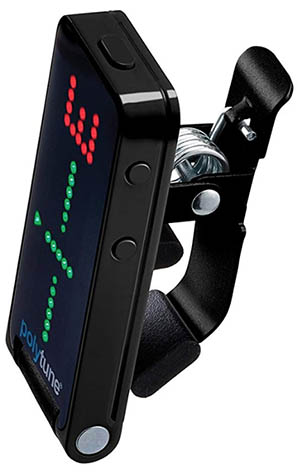
This would be just another gimmick feature if it required the user to change the setting, or press any buttons. The best part of this tuner is the user experience and the design of the modes. Strum more than one string and the tuner will be in multiple string mode. But as soon as you only play one string it instantly switches to the single string mode. This flawless integration of modes and instant switching between them makes this tuner a pleasure to use and incredibly useful.
The construction of the PolyTune Clip must also be called out. It uses an all metal clip which is incredibly durable and will not break from repeated use. The clap is strong but won’t damage your instrument, and the body has a quality feel to it.
The display is bright and easy to read. However, when in multiple string mode, the indicators for each string are on the smaller side. I’ve never had any issue with this, but some readers who made have worse eyesight might elect to go with the Snark or the D’Addario for this reason.
The design makes this, by far, the best looking clip on tuner on the market. In black, this tuner is sleek and looks great. This may be the only tuner that I’d leave on my guitar in a live setting, it really looks that good. Bulkiness factor is next to nothing, and one of the best parts about this tuner is that it only has one pivot point. A good old hinge which tilts the tuner face towards you. I love the single pivot design as it reduces the number of areas the tuner can fail.
The Good: The TC Electronic PolyTune Clip is in the highest echelons of clip on tuners. It performs every function incredibly well, looks awesome, and is built like a tank. The multiple string tuning setting is truly unique and is accessed through a seamless user experience.
The Bad: The only negative thing about this clip on tuner is the price. It is one of the most expensive clip on tuners on the market at a typical sale price of $60. Sure this a lot of money, and about 4 times more expensive than your standard clip-on. However, this is an awesome investment that will last for a very long time. If you have a nice guitar, don’t skimp on a tuner.
Conclusion: The TC Electronic PolyTune Clip is an impressive and unique clip on tuner that will work great for acoustic, electric or bass. I highly recommend this tuner if you have quality instruments and want a tuner to match. While this is the highest priced clip on in our recommendations, it makes a great gift for any guitar player that you know. This tuner features the highest possible quality and functionality of any tuner on the market today.
Commonly asked questions about clip on tuners
Does it need to be quiet for a clip on tuner to work?
Clip on tuners work off of vibration that is felt through the physical connection of the tuner’s clamp to the instrument. Because of this, it is important to ensure that the clip on tuner’s contact points are clean and clear of debris, and that the clamp makes a solid connection with the guitar’s headstock. While early clip on tuners mixed microphones and internal vibration mics, modern clip on tuners work through vibration alone.
This typically makes a clip on tuner a great option for a noisy setting like a club or bar. Depending on the instrument, it may be more likely to pick up extraneous sounds. For instance, an acoustic guitar is going to pick up the vibrations of the bass player noodling around behind you than a solid body electric guitar will. For this reason there may be a little bit of bleed, but this shouldn’t be much. If tuning an acoustic guitar in a noisy setting with a clip on tuner, put one arm across the top of the guitar limiting or dampening its vibrations. This will help isolate the guitar and keep outside sounds to a minimum.
It does not need to be quiet for a clip on tuner to work as the tuner is designed to tune through physical vibrations and not through sound.
Do clip on tuners work on all instruments?
As I rant about earlier in this article, I don’t think it should be legal to even sell instrument specific (guitar, bass, violin, ukulele, etc) tuners. I might be a bit dramatic with that thought, but their usefulness compared to a chromatic tuner just isn’t there. If you have a chromatic clip on tuner, it will work on all instruments to which the tuner can be securely clamped.
Remember the clip on tuner works by detecting the physical vibrations and requires a strong connection to do so. Some clip on tuners are limited by the range at which the clamp can open. Some instruments, like violin, require a tuner that has a larger clamp. Double check the clamp opening with the width of the headstock of your instrument to determine if it will fit.
Clip on tuners are not just for guitar and bass. They can be used on all instruments as long as the clip on tuner can be securely clamped to it.
How long do clip on tuner’s batteries last?
I have been using the D’Addario Eclipse clip on tuner for the past 2 years and the battery just finally went out on me. I use it multiple days a week, and oftentimes multiple times a day. Battery life is going to depend on the type of tuner, how often you use it, and if you’re good about turning it off right away. While all the clip on tuners reviewed in this article have an automatic off function, it’s a good habit to develop to always turn the tuner off right after you’re done tuning. This will extend the life of the clip on tuner’s battery as much as possible.
When I worked at a guitar shop, the clip on tuners that we used would fly through batteries as we would be using them all day everyday. In those cases typical batteries will last 1 or 2 months.
What kind of battery does a clip on tuner use?
Most clip on tuners use standard watch, or pancake batteries that can be bought in bulk from Amazon fairly cheaply. Some tuners are popping onto the market which have a reusable battery that has an adapter and must be charged once it has expired. Stay away from these tuners as they make a pretty useless paperweight once that rechargeable battery no longer works.
All of the clip on tuners reviewed in this article (the D’Addario Eclipse, Snark SN-8, TC Electronic PolyTune Clip) use a CR2032 3v battery. I like to buy these from Amazon in the Energizer 25 pack, as that’s the cheapest per unit option, has free shipping for Prime members, and works for my instant read meat thermometer as well! Two birds with one stone.
Most clip on tuners are likely to use the CR2032 battery, but check the specs for your specific tuner on the manufacturer’s website to make sure before buying a huge bulk of them.
How do you use a clip on tuner?
Clip on tuners are incredibly easy to use. Simply clamp the tuner to the headstock of the instrument. If you’re not tuning an instrument with a headstock just make sure the tuner’s clamp has a solid physical connection to the instrument.
Turn the tuner on and pluck each open string cleanly and clearly. Tune the instrument to the pitch desired as indicated by the clip on tuner’s onboard screen. It will tell you the note that you’re tuning to and if you’re sharp or flat.
TIP: If your clip on tuner is having difficulty picking up the vibrations of the string your plucking, play the harmonic at the twelfth fret. Especially for the lower register, like bass guitar, sometimes clip on tuners have a hard time picking those tones up clearly. The harmonic gives the tuner a strong vibration at the original frequency and the exact double of it. The clip on tuner will now be able to accurately tune your strings.
What’s the difference between a guitar tuner and a chromatic tuner?
A guitar only tuner is a piece of garbage that should have never been invented in the first place, whereas a chromatic tuner is the only tuner you need to buy. There, case closed right?
A guitar specific tuner only tunes to the notes in standard tuning. For guitar this is EADGBE. While this might sound like it makes tuning easier for guitar players and especially beginners, it actually makes it much harder. Let me give you an example. If I’m trying to tune my D string and it’s currently at an E a whole step above where I want to be, the tuner isn’t going to know that I’m trying to tune the 4th string. Instead of indicating sharp it will either say “sure let’s get that note tuned to an E because that note exists in the guitar’s standard tuning,” or won’t detect it at all because that E (155.56 hz) is not the same frequency as the other E’s in the guitar’s standard tuning (low E = 82.41, high E = 329.63).
And that’s just if we want to tune to standard. What if I want to tune to drop D, or DADGAD, or ½ down? What then? The “guitar” tuner is now worthless, surprisingly more worthless than it was before.
A chromatic tuner, on the other hand, shows you every note (including sharps and flats) that you string is tuned to. It shows you what you’re actually tuned to, not what you want to tune to. This is a big difference, and is incredibly important for a beginner to learn the concept of the notes and their relationship to each other. A guitar specific tuner is detrimental to the learning of beginner guitar players and should never be used. There, I said it. They should never be used. I hope everyone stops buying them so that the manufacturers stop making them. What a waste of money.
Should I use a clip on tuner or a pedal tuner?
If you are playing live, I highly recommend using a pedal tuner. Bonus points for using a volume pedal with an always on tuner out. This is the best setup for a live situation as it allows for silent tuning, with the quick toe touch of the tuner pedal or volume pedal.
There are three reasons you should use a pedal tuner when performing live.
- Engage the tuner for silent tuning. You don’t want to be changing the volume of your guitar on the instrument to mute the output while you tune using a clip on tuner as this will cause variations in your volume and drive the audience and sound guy crazy. You also don’t want to tune not silently, as this will drive your audience crazy faster than a bad cover of In An Aeroplane Over the Sea.
- A pedal tuner allows for switching of instruments. You do not want to unplug an instrument from an amp, PA, or DI in a live situation. This will cause a loud pop that can both be damaging, and again annoying for you audience. A pedal cuts the output and allows for the swapping of instruments silently. Ahhhhh, hear that? Yeah neither did I, and that’s how it’s supposed to be.
- Lastly, but certainly not leastly, is professionalism. When you’re on stage you are a performer, and a performer needs to look good and professional. Tuning with a clip on tuner just doesn’t look professional. In fact, leaving something on the end of the headstock looks incredibly unprofessional. In fact — take that capo off your headstock while you’re at it. There, now you look good. Just make sure you have a pedal tuner and you’ll look really good.
Clip on tuners are incredibly handy, but should not be used in a live setting. Or they should at least be used sparingly.
When I’m at home, or playing in a space where it isn’t practical to use a floor tuner, I always use a clip on tuner. It used to be the case that pedal tuners where faster and more accurate than clip on tuners. This isn’t the case anymore, and I’d put my D’Addario Eclipse up against my Boss TU-2 any day.
In a live setting, use a floor tuner. Everywhere else, use a clip on tuner if your floor tuner isn’t handy.
Can I keep a clip on tuner on the headstock?
It’s tempting to clamp a clip on tuner onto your guitar’s headstock and just leave it there. Most of them are sleek enough that they fit into the case like that, so why not just leave it there? It saves time and hassle.
Do not leave a clip on tuner on the headstock of a guitar! I know it’s tempting, but over time this will damage the finish of the guitar, oftentimes discoloring the spot where it’s been sitting.
Short term use, a clip on tuner is perfectly safe to use on most guitars. I say most guitars, because special care needs to be taken if you’re playing a vintage guitar with a nitro finish that may be checking and becoming brittle. In this case, the clamp of a clip on tuner could conceivably break of finish from the guitar doing irreparable damage. Care must be given to vintage instruments, and this is a good example of one of those times.
However, those times are incredibly rare, and if the finish on your guitar is in good condition you have nothing to worry about sticking a clip on tuner to the headstock. Again though, you don’t want to leave it on there as the material of the clamp can discolor the instrument over time. This is especially true in high humidity climates.
Use the clip on tuner while you’re playing your guitar, but make sure to remove it when you’re done.
Does a clip on tuner pick up the harmonic better than the open string?
As mentioned earlier, this is a trick I like to use if the tuner isn’t picking up the note. Clip on tuners are getting better at picking up lower notes, but sometimes the low E on a bass is difficult of a tuner to pick up. Playing the harmonic at the 12th fret gives the tuner both the low E frequency as well as the octave above it. As soon as you hit that harmonic, the tuner typically snaps right to the note.
Are guitar tuning apps any good?
There are a ton of free and paid guitar tuning apps out there for your mobile phone. I have one installed on my iPhone, but only use it when I have nothing else. Because it only works on sound through the microphone, a mobile tuning app needs to be used in a quiet space, and placed close to the guitar. This works decently for acoustic guitar, but isn’t useful for electric.
GuitarTuna is by far the most popular mobile guitar tuning app. One of the things that bothers me about the GuitarTuna app is that it is setup like a guitar specific tuner and the chromatic setting is only available through the paid version. This makes the tuner basically useless to me and is frustrating to have a free version that is useless to me. I understand that app makers should be paid for their work, but I think I’ve accurately portrayed my distrust and disgust of guitar specific tuners. This one is no different.
While tuning apps work fine in a pinch, a clip on tuner is a much better option and don’t cost that much more.
